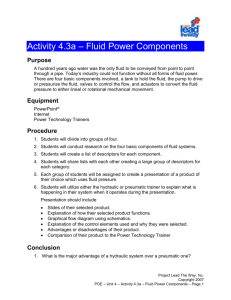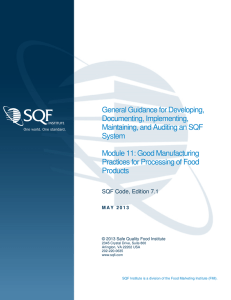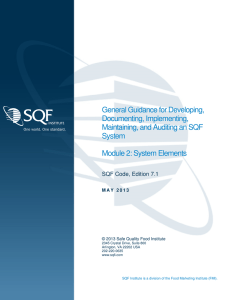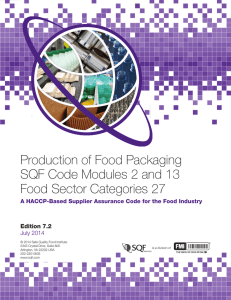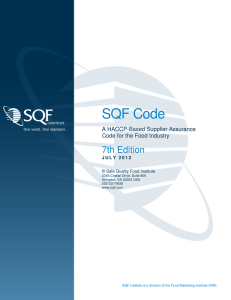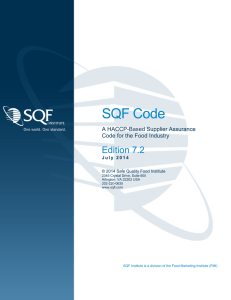U3f L1 Fluid Technology 1
advertisement
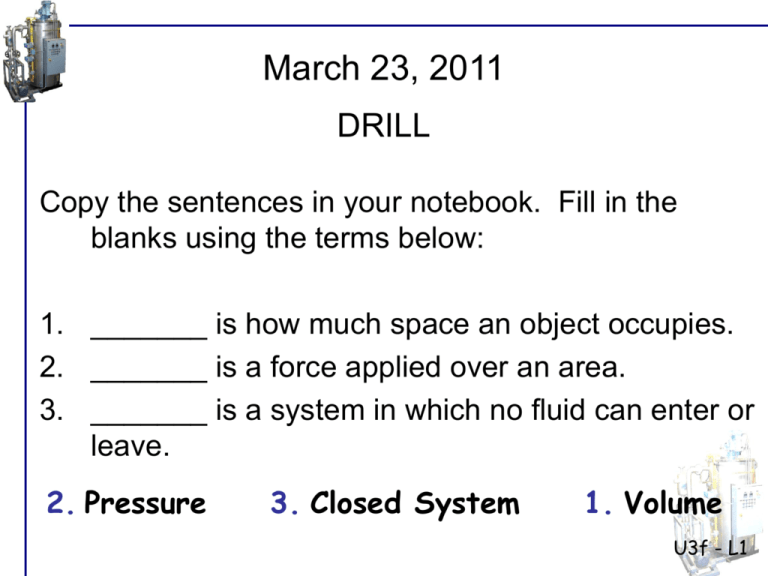
March 23, 2011 DRILL Copy the sentences in your notebook. Fill in the blanks using the terms below: 1. _______ is how much space an object occupies. 2. _______ is a force applied over an area. 3. _______ is a system in which no fluid can enter or leave. 2. Pressure 3. Closed System 1. Volume U3f - L1 UNIT 3 – Engineering Design Engineering, the systematic application of mathematical, scientific, and technical principles, produces tangible end products that meet our needs and desires. U3f - L1 UNIT 3 – Engineering Design a. b. c. d. e. Getting familiar with the Big Idea The Design Process Core Technologies Mechanical Technology Electrical Technology f. Fluid Technology g. h. i. j. Thermal Technology Optical Technology Materials Technology Reverse Technology U3f - L1 Fluid Technology PURPOSE OF SUB-UNIT • To familiarize students with the functioning and applications of fluid technology systems. U3f - L1 Fluid Technology What is technology? The application of knowledge, tools, and skills to solve problems and extend human capabilities. What is a technology system? A Technology System is a group of subsystems working together to solve problems and extend human capabilities. U3f - L1 Fluid Technology • There are several engineering resources (core Core technologies) that are theMechanical “building blocks” of all Technologies technology systems. Structural Electrical Electronic Thermal • We could store the core technologies on shelves Fluid Optical • We can go to those shelves and use technologies according to our needs in problem solving. Bio-Tech Material U3f - L1 What is Fluid Technology? • The technology of using fluid, either gas (pneumatics) or liquid (hydraulic) to apply force or to transport. Example applications: •Air brakes on a truck, •Tires on a car, •Airfoils on an airplane, •Warm-air heating ducts, •Hydraulic jack, •Plumbing in a school •Hydro-electric dam U3f - L1 Other applications of Fluid Technology… • Blood flow in capillaries (only a few micro-meters in diameters) • Crude oil across Alaska through 800-mile-long, 4-ft diameter pipe • Streamlined, smooth surfaces of airplanes for efficient air flight • Dimpled, rough surfaces of golf balls for efficient flight • Why does a stream of water from a faucet sometimes appear to have a smooth surface, but sometimes a rough surface? • How does aerodynamic design of cars and trucks affect U3f - L1 gas mileage? What is a FLUID? • College engineering text definition: – a substance that deforms continuously when acted on by a shearing stress of any magnitude • Standard definition: – a substance (as a liquid or a gas) that conforms to the outline of its container • Fluid Systems have 2 things in common: – They contain a fluid, either gas (pneumatics) or liquid (hydraulics) – They contain a pressure difference that creates a net force U3f - L1 FLUID PRINCIPLES • Area – a surface within certain boundaries – Typically 2-dimensional • Volume – the amount of space an object occupies – 3-dimensional • Force – a push or pull • Pressure – a force applied over an area Your stands on Whatteacher is the area of the What is of theof total volume this piece wood onof the portion this piece of this piece of lumber? floor. lumber that sits on the floor? (Convert all units to What is the pressure inches first) applied toallthe floor (Convert units to 48” x 2” = 96 cubic inches beneath the wood? 4” x 12” = 48 square inches inches first) U3f - L1 FLUID PRINCIPLES • Pressure is a force applied over an area. • What are some typical units for pressure? – Psi (pounds per square inch) • Pressure = Force / Area Your teacher (weighing 165 pounds) stands on this piece of wood on the floor. What is the pressure applied to the floor beneath the wood? P=F/A P = 165 lbs / 48 in2 P = 3.44 psi F = 165 lbs. A = 48 square inches U3f - L1 U3f - L1


